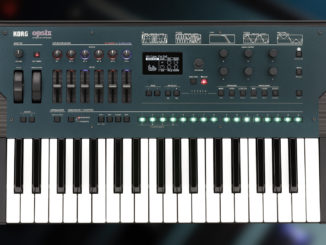Korg revives its 2013 golden VA Synthesizer as KingKORG NEO for NAMM 2024 with a new, modern look and new features including a vocoder.
In 2013 Korg released the KingKORG. A flagship virtual analog synthesizer that particularly stood out because of its golden finish. But it wasn’t a big hit at the time. Ten years on, technology has moved on, and history repeats itself. The KingKORG is back.
For NAMM 2024, Korg has introduced the KingKORG NEO, a comeback of the VA synth. In a much more compact formant and new modern features.
Korg KingKORG Neo
The KingKorg NEO revives and furthers the virtual analog engine of the Kingkorg Synthesizer from 2013 in a new, more compact form. It features a new engine called XMT (expanded modeling technology) with bi-timbrality and up to 24 voices.
Each layer features a synth voice consisting of three oscillators. These are powered by pre-set algorithms that offer different synthesis options. It offers classic sawtooth and square sawtooth but also interesting noise patterns typical of analog synths.
Besides the 32 classic analog-style waves, you have 65 PCM and 40 DWGS sound sources. From here, it goes into a multi-mode analog-modeling filter featuring seven lowpass, five high pass, and six bandpass filter types.
You can find emulation from various Korg synths here, including the iconic Polysix and MS-20 filter. Filters we already know from the Korg modwave, wavestate, and opsix. According to Korg, they can self-oscillate
Effects & Vocoder
Besides the filter, the new KingKORG Neo also features an extensive multi-effects section with three master effects slots, each offering six distinct effect types. It includes effects like distortions, amp sim, phaser, chorus, reverb, delay, and more.
A highlight of the new KingKORG Neo is the built-in vocoder accessible via the balanced XLR input on its front panel. It also ships with a rugged, high-quality microphone. The vocoder core consists of a sophisticated 16-band filter with advanced controls (formant shift, pan of each band…), you can achieve a wide range of vocoder sounds.
Another intriguing function is the ability to use the timbre B of the KingKORG Neo as a modulator, providing an alternative to the traditional microphone input. This allows the vocoder effect to be seamlessly blended with the synth sound,
Moreover, each of the three oscillators, A and B timbres, can be individually selected as a source for the microphone input. This unique feature enables you to synthesize a rich mix of voice and instrument, creating a fusion of timbres that’s both innovative and captivating, says Korg.
Virtual Patch System
Another highlight of the KingKORG Neo is a new virtual patch system that takes inspiration from workflow like found on the MS-20. Not sure, how deep this goes but Korg says it offers six virtual patch assignments for each timbre. These can be virtually connected with control signals like envelopes, LFOs, or joystick movement.
Further, it comes with a flexible built-in step arpeggiator with different types and the option to automatically generate arpeggio phrases based on the chords your play. You can also specify the duration, interval, and on/off status of each step, opening up a vast array of rhythmic possibilities.
Layout
The layout is a bit spacy and unusual at first glance. The case looks suspiciously the same as that of the modwave, opsix, and wavestate. Check the back and you will see it.
So, also probably based on the Raspberry architecture. It has the same case but it’s not based on the Raspi platform. It uses its own electronics, confirmed the Dan from the Korg RD team.
There are three displays on the interface, many knobs and buttons. It is noticeable that a lot of things were taken from the original KingKorg.
The oscillator section has its own display, which is cool. Super big, on the side, is the effect section with three big knobs that selects the algorithm type. Yes, a very unique layout.
First Impression
I’m pleased to see that Korg is reviving the KingKorg again as a NEO version. The design is unusual and certainly stands out. The new features are solid, but the price is a bit high for a VA of 2024.
Korg KingKORG Neo will be available soon for $999,99.
More information here: Korg







Looks great but yeesh, that price is a bit much. I can see $600usd, maybe.
At first sight, only a few differences with the KingKorg. It looks look it has the same XMT engine, same 24 voices, OSC, Filter types, Envelopes, LFO’s and FX. Even the virtual patches were present, as well. Also the vocoder and bi-timbrality aren’t new. The amount and even the type of knobs is very similar.
There are less DWGS waveforms and more PCM waveform… not sure that is an improvement. The Polysix filter was not present on the old model, but MS-20, Moog, Oberheim, Prophet-5, Acid… all there.
The VA sound of the old synth was really, really good. Someone can compare old and new soundwise?
In comparison with the old KingKorg (I have the black model), with the NEO you loose 2 octaves and the distortion tube. And its price is 300 EUR more than what I paid new, 3 years ago.
So not clear to me what this NEO offers that motivates its price tag.
It looks like this is another synth built on Korg’s 2020 digital platform – when you see the case from the side, it looks like a Wavestate but with white plastic instead of black. Are they still using the same no-aftertouch, budget midi controller-feeling keybed? In a $1k synth?
yes only velocity and release-velocity sensitive)
Re this: “So, also probably based on the Raspberry architecture.”
The physical case is similar, but internally this uses its own electronics; it is not built on the same Raspberry Pi-as-massive-DSP platform as the wavestate/modwave/opsix.
Thanks for the clarification Dan
After seeing some reviews, I don’t think the Polysix filter is present. These are still the same 18 filter types as in the original KK.
Maybe Korg should call this one the PrinceKorg!